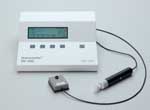

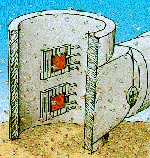
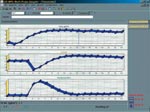
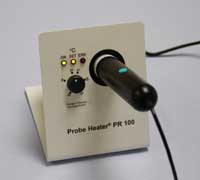
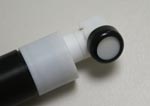
Transepidermal Waterloss (TEWL) - Tewameter® TM 300
The measurement of the transepidermal waterloss (TEWL) is the most important parameter for evaluating the efficiency of the skin water barrier. Since 1990 CK has been manufacturing one of the most accepted and best selling TEWL measurement devices, the Tewameter® TM 210. Many international scientific studies demonstrate its importance in dermatological and cosmetological fields. Thanks to long experience in producing scientific skin measurement devices, next generation electronics and very close contact with the users, the Tewameter® TM 300 is a giant step forward in the technology of skin research. The measurement of the TEWLvalue allows an early determination of even the slightest damage in the skin water barrier.
Measuring of Transepidermal Waterloss (TEWL)
There are various fields of applications. Besides efficacy testing and claim support for cosmetics and pharmaceuticals, and objective clinical diagnosis in dermatology, there is a large application in occupational medicine, medical consultancy, observation of the newborn, the food industry and many more fields.
The Measuring
Principle The measurement of the water evaporation is based on the diffusion principle in an open chamber dm/dt=-D x A x dp/dx
where: A = surface in m², m = water transported (in g), t = time (h), D = diffusion constant (=0.0877 g/m(h(mm Hg), p = vapour pressure of the atmosphere (mm Hg), x = distance from skin surface to point of measurement (m)
The Probe
The density gradient is measured indirectly by the two pairs of sensors (temperature and relative humidity) inside the hollow cylinder and is analysed by a microprocessor. The small size of the probe head minimizes the influence of air turbulences inside the probe. Also the low weight of the probe has no influence on the skin surface structure and allows easy handling. All calibration data are inside the probe. Thus the probe is completely self contained and can be connected to different device types.
Open and closed chamber measurements are possible. The measuring principle is based on the open chamber measurement. With this method continuous measurements, which are necessary for most applications, are possible without influencing the skin surface. Due to the modern, high quality electronics of the probe a stable measurement result is achieved very quickly. For special applications measurement values can be recorded over a long time (days).
For even more quickly stable measurements we have developed the Probe Heater PR 100, which keeps the probe head to a certain temperature of 28-32 ºC (corresponding to skin temperature).
In some cases, where closed chamber measurements might be needed, the probe head can also be used as a closed chamber, to achieve a result after very few seconds.
SSWL-Measurement
Besides the TEWL value, the calculation of the SSWL-value (skin surface waterloss after occlusion) and the partial water evaporation pressure (pd) are possible.
Heating of the Sensors
If skin temperature differs highly from the actual air temperature, the sensors inside the probe head can be preheated to a temperature close to that of the skin for quick
Sensor Regaining
A conditioning function (heating the sensor to approx. 70 ¡ãC) removes dirt particles from the sensor head. This ensures greater accuracy and prolongs the life of the probe.
Check Calibration
The new technology of the probe does not require frequent, complicated and time consuming recalibration with different solutions. The accuracy of the probe can be checked at any time by a small electronic unit.
Display
Separate display of the values for the upper and lower relative humidity and temperature sensors in the probe. The information about temperature and humidity during the TEWL-measurement is of great importance for the evaluation of the accuracy of the TEWL results.
Disposal rings to keep the probe head hygienical (e.g. for measurements on wounds) or special caps for different applications are available on request.
A room condition sensor to measure the rel. humidity and temperature of the environment can be connected to the system. and stable TEWL-measurements. __
Technical Data
Dimensions: Hollow cylinder: height 2 cm, 1 cm, Weight: 90 g, Probe length: 15.3 cm, Cable length: 1.3 m
Resolution: Humidity: +- 0.01 % RH, Temperature: +- 0.01 ¡ãC
Accuracy within 10¡ã C to 40¡ã C and for TEWL-values lower than 70 g/hm²: relative humidity (RH): +- 1.5 % RH in the range of 30 % RH to 90 % RH; +- 2.5 % RH in the range of 90 % RH to 100 % RH; +- 2.5 % RH in the range of 0 % RH to 30 % RH waterloss: +- 0.5 g/hm² for RH 30 %; +- 1.0 g/hm² for RH 30 % temperature: +- 0.5 ¡ãC
Technical changes may be made without prior notice.
¡¡
